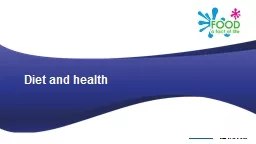

Introduction Micronutrients are needed in the body in tiny amounts They do not provide energy but are required for a number of important processes in the body There are two main groups of micronutrients ID: 914385
Download Presentation The PPT/PDF document "Iron deficiency anaemia" is the property of its rightful owner. Permission is granted to download and print the materials on this web site for personal, non-commercial use only, and to display it on your personal computer provided you do not modify the materials and that you retain all copyright notices contained in the materials. By downloading content from our website, you accept the terms of this agreement.
Slide1
Iron deficiency
anaemia
Slide2Introduction
Micronutrients
are needed in the body in tiny amounts. They do not provide energy, but are required for a number of important processes in the body.
There are two main groups of micronutrients:
vitamins;
minerals and trace elements.
Iron is an example of a mineral.
Minerals are inorganic substances required by the body in small amounts for a variety of different functions
.
Slide3Iron (Fe)
Iron is needed for:
the formation of haemoglobin in red blood cells;
transport
of oxygen in the body;production of energy;function of the immune system;reduction of tiredness and fatigue.
Slide4Iron (Fe
)
sources
Did you know?
There are two types of iron; one from animals sources (haem iron) and the other from plant sources, fortified foods and supplements (non-haem iron).Haem iron is readily absorbed by the body. Vitamin C helps the absorption of non-haem iron when eaten at the same time.Sources of iron include: offal, red meat, beans, pulses, nuts and seeds, fish (e.g. canned sardines, cockles and mussels), quinoa, wholemeal bread and dried fruit.
Slide5Reference Nutrient
Intakes (RNI)
for iron
The RNI is the amount of a nutrient that is enough to ensure that the needs of nearly all the
population (97.5%) are being met. The RNIs for iron shown in the table below are in mg/day.
No. of
people
Requirements
RNI
Age
Males
Females
1-3 years
6.9
6.9
4-6 years
8.1
8.1
7-10 years
8.7
8.7
11-14 years
11.3
14.6
15-18 years
11.3
14.8
19-50 years
8.7
14.8
50+ years
8.7
8.7
Slide6Iron (Fe)
Teenage girls and women of childbearing age need more iron than males of the same
age, meaning they have a higher RNI.
Over
half of teenage girls in the UK do not consume enough iron and intakes are also low in a large proportion of young women. A lack of iron may lead to iron deficiency anaemia.Did you know?More than 2 billion people worldwide suffer from iron deficiency anaemia, making it the most common nutritional deficiency.
Slide7Iron deficiency
anaemia
A lack of dietary iron depletes iron stores in the body and this can eventually lead to iron deficiency anaemia.
In particular, women of child bearing age and teenage girls need to ensure they consume adequate dietary iron because their requirements are higher than those of men of the same age
.Also, loss of blood due to injury or large menstrual losses increases iron requirements in the short term.
Slide8Iron deficiency
anaemia
Teenage
girls and women of childbearing age need more iron than males of the same age making them at increased risk of deficiency.
Symptoms of iron deficiency anaemia can include: tiredness and lack of energy; shortness of breath; noticeable heartbeats (heart palpitations) or pale skin.Iron deficiency anaemia is usually tested by a full blood count (FBC) test.
NHS
Slide9Long term health problems
If iron deficiency anaemia is left untreated, it can
increase
illness and
infection risk.Severe iron deficiency anaemia may increase the risk of developing complications that affect the heart or lungs, such as an abnormally fast heartbeat or heart failure.Pregnant women with severe or untreated anaemia also have a higher risk of complications before and after birth.
NHS
Slide10Iron deficiency
anaemia
treatments
The most common treatment
for iron deficiency anaemia involves taking iron supplements. This is usually effective, and the condition rarely causes long-term problems.After treatment, a patients will need to be monitored every few months to check
whether their iron
levels have returned to normal
.
The underlying cause will
also need
to be treated
to
avoid developing anaemia
again. This could include increasing the amount of iron in the diet.NHS
Slide11Iron deficiency
anaemia
For further information, go to:
www.foodafactoflife.org.uk